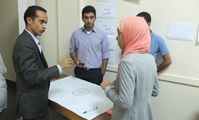FUNERAL PRACTICES AND MUMMIFICATION

The art of embalming bodies and transforming them into mummies wasbelieved to be of divine origin and to go back to Horus the son of Osiris andIsis. The term mummy comes from the Arabic « mumiya » or « mumyai » whichaccording to the 12th century Arab traveler Adb-el-Latif refers to bitumen or amixture of pitch and myrrh, a material which was extensively used inthe treatment of corpses and which was an important item of commerce even inmedieval Europe. At one time a careful distinction was made betweennatural and artificial mummies, the former category being those which remainedintact without treatment. Even today it is believed that the spectacularstate of conservation of Egyptian mummies is due more to the extremely aridEgyptian climate, with the resulting total absence of bacteria in the air andsand, than to the embalming process.
Thanks to the presence of well preserved bas-reliefs and paintings in thetombs we have a very good idea of how funerals were conducted in ancient Egypt.Opening the funeral procession would be a group of slaves carrying offerings andobjects belonging to the dead man. If he had been a warrior there would be hisweapons, if he had been a farmer there would be his farming implements. Nextwould come a group of professional mourners uttering piercing cries, tearingtheir hair and singing dirges. Finally behind the master of ceremonies and thepriest would be the catafalque in the shape of a solar barge, mounted on asledge drawn by a team of oxen. Family, friends and relatives followed, dressedin mourning, uttering cries and lamentations. Right at the back of theprocession would be a group of women singing the praises of the dead man. Alongthe way would be gathered the idle and the curious. If the cemetery was on theother bank of the Nile, the funeral procession would cross the river, thecatafalque would be placed once again on its sledge and the different groupswould form up again in the same order. When finally they arrived at the tomb themummy would receive the offerings and the final good-byes of family and friends.There then followed the « ceremony of the opening of the eyes and mouth »by means of which the dead person had their senses restored to them. The mummywould then be laid in the tomb.
Weshall now look into the question of how the body was mummified. The body of thedead man was handed over to specialists who proceeded to embalm it. Thefirst operation consisted of extracting the brain via the nostrils by means of ahooked tool. The brain cavity was then filled with a material consisting mainlyof liquid bitumen which hardened on cooling. The eyes were then removed andreplaced by porcelain substitutes. By means of a sharp stone an incisionwas then made in the left side of the body and the intestines and internalorgans removed. These were treated with boiling bitumen and wrapped up. Thebrain and the liver were treated in a similar way. The viscera were preserved infour canopic jars made of clay, limestone or alabaster, in some cases even ofstone or metal depending on the station of the dead man. These jars whichwere placed in a coffer near the mummy had lids each of which had a differenthead on it: man, jackal, sparrow-hawk and dog faced baboon. The cavities in thegut and stomach were carefully washed with palm wine, dried with a powderedmixture of aromatic plants and finally filled with myrrh or perfumedsawdust. The body thus prepared was placed in a solution of natron (sodiumcarbonate) and left for seventy days. After this treatment the flesh and muscleshad completely dissolved away and nothing remained except the skin attachedto the bones. The hair of men was cut short while that of women was left in itsentire splendor.
Bandages impregnated with resin were wound round each finger then roundthe hand and finally round the arm. The same procedure was carried out on theother limbs. For the head even greater care was taken. The cloth in directcontact with the skin was rather like muslin. The face was covered with severallayers of this material and the degree of adhesion was so perfect that whenremoved as a whole it could be used as a mold to make a plaster cast of the deadman's features. The whole body was then wrapped up in the same way. Thebody was arranged in an extended position either with the hands crossed onthe breast or with the arms extended along the flanks. The bodies of thepharaohs were wrapped in a sheath of repose gold work which reproduced the shapeof the body in relief. The state of preservation of the mummies in theEgyptian museums in Cairo and Alexandria as well as those in foreignmuseums is pretty well perfect. The oldest known mummy is that of Sekkeram-Saef,son of Pepi I (IVth dynasty) which was discovered at Sakkarah, near Memphis, in1881 and which is now in the Cairo Museum. The great skill of the embalmers hasthus enabled the likenesses of the great pharaohs to be transmitted to us downthe centuries. In the withered head of Mernefta, believed by many to be thepharaoh of the Jewish Exodus, we can still recognize the characteristic familynose as well as the eyebrows which are still quite thick. In that of Ramses IIX-ray examination has shown that he undoubtedly had trouble with histeeth.
Your Rating:
Overall rating: 2.000
Totally voted: 1
Comments
Weather in:
Exchange Rates
-
IMF loan expected next month
Apr 22, 2013, rating: 3.000, 3 votes Egypt may secure an International Monetary Fund loan agreement in about amonth, state news agency MENA reported, quoting "informed" sources ...
Egypt may secure an International Monetary Fund loan agreement in about amonth, state news agency MENA reported, quoting "informed" sources ...
-
Country's diesel reserve only enough for three days.
Feb 05, 2013, rating: 5.000, 1 votes Egypt’s strategic reserve of diesel fuel used for trucks and grouptransport vehicles can meet demand only for three days ...
Egypt’s strategic reserve of diesel fuel used for trucks and grouptransport vehicles can meet demand only for three days ...
-
Egypt received 11 million tourists in 2012 and aims to boost that number to 14 million in 2013.
Jan 22, 2013, rating: 3.000, 2 votes
Egypt received 11 million tourists in 2012 and aims to boost that number to 14 million in 2013.
-
Egypt limits travelers leaving country to US$10,000 in cash
Dec 26, 2012, rating: 3.250, 4 votes Egypt has banned travelers from carrying more than US$10,000 in foreigncurrency cash in or out of the country ...
Egypt has banned travelers from carrying more than US$10,000 in foreigncurrency cash in or out of the country ...
-
National Coalition on Climate Change for Egypt is born
Nov 30, 2012, rating: 5.000, 1 votes The global COP18 conference on climate change opens in Doha Monday.About 17,000 participants from all over the world ...
The global COP18 conference on climate change opens in Doha Monday.About 17,000 participants from all over the world ...
-
Egyptian family's average annual income is LE25,000, agency reports.
Nov 29, 2012, rating: 5.000, 1 votes The average annual Egyptian household income during 2010-2011 wasLE25,353, according to the Central Agency for Public Mobilization andStatistics.
The average annual Egyptian household income during 2010-2011 wasLE25,353, according to the Central Agency for Public Mobilization andStatistics.








